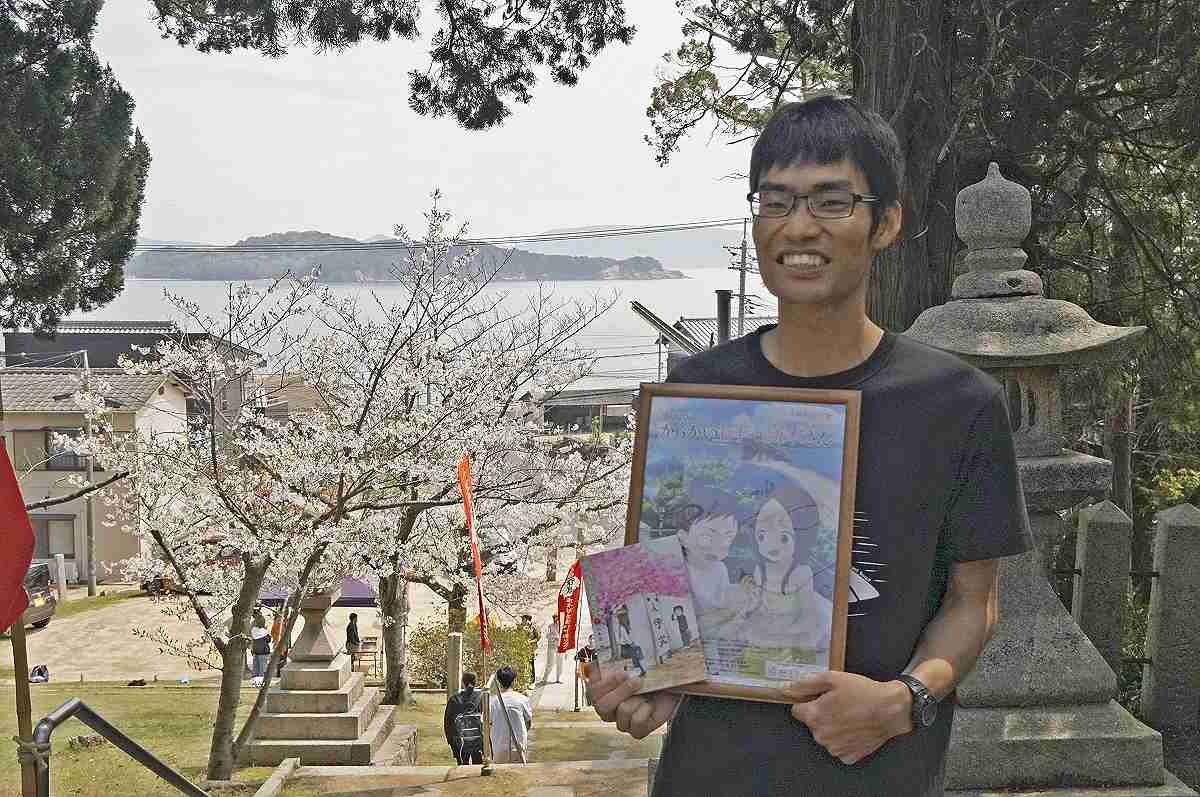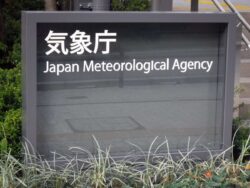Anime Fans Moving to their ‘Holy Pilgrimage’ Destinations; Cities Find New Ways to Promote Growth

Kotaro Kumamoto smiles while holding anime goods from “Karakaijozu no Takagi-san” (Teasing Master Takagi-san) in his hands in Tonosho, Kagawa Prefecture.
12:33 JST, September 20, 2024
TAKAMATSU — It has become popular for anime fans to make “holy pilgrimages” to locations connected to movies and other productions, and some anime fans have even chosen to live in such areas. There is a municipality trying to attract people by providing relocation consultations aimed at anime fans, which is attracting attention as a new form of regional development.
Kotaro Kumamoto, 28, works for a company which runs an olive farm on Shodoshima island in Kagawa Prefecture. He moved to the island in the Seto Inland Sea from Okayama Prefecture in April 2022 after frequenting the area as a fan of “Karakaijozu no Takagi-san” (Teasing Master Takagi-san).
Shodoshima is the setting for the popular anime. Mangaka Soichiro Yamamoto set this junior high school romantic comedy manga on the island he is from, and it was made into a TV anime series in 2018.
Kumamoto said he became a fan of the anime because he was amused by the exchanges between two main characters, female junior high school student Takagi-san and Nishikata, the boy who sits next to her at school. “I wanted to continue watching over them,” he said.
Kumamoto visited the island for the first time in the summer of 2018 when he was a student at Okayama University. He was impressed with the scenery there, which was just like what he saw in the anime. The sights included that of the road to the two students’ school, the school itself and a shrine they stopped by on their way home. While frequenting the island, Kumamoto also discovered the appeal of olives, the island’s specialty product.
Kumamoto worked at a strawberry farm in Okayama Prefecture after graduating from university but moved to the island two years later.
“While frequenting the island in search of the extraordinary world of anime, I was able to find out about how people live on the island. I felt that I would be able to enjoy myself here forever,” he said.
Relocation consultation
Visiting “sacred places” related to anime and other productions is believed to have been started by fans of “Lucky Star.” They rushed to a shrine in Kuki, Saitama Prefecture, featured in the anime in 2007.
Oarai, Ibaraki Prefecture, is the setting for the anime “Girls und Panzer,” which features female high school students engaging in tank warfare as a competitive sport. Panels depicting characters from the anime are exhibited around town.
An official of the town’s community development promotion section said they think at least 100 people have moved into the town because of the anime.
Akira Osato, 47, chairman of the Oarai Tourist Association, welcomes the newcomers. “Some of them have started a coffee shop or become volunteer firefighters, assimilating into the community,” Osato said.
In February, Numazu, Shizuoka Prefecture, organized the first relocation consultation for fans of “Love Live! Sunshine!!” an anime about high school girls who devote themselves to becoming pop idols.
According to the city, appointments for the consultation were fully booked within 30 minutes of reservations opening, and 15 groups received consultations. One of the 15 is said to have already moved to Numazu, and another has been considering relocation to the city.
Takeshi Okamoto, a professor of tourism studies at Kindai University, said the idea of anime fans moving to “sacred sites” is actually not new.
“Anime fans tend to feel an affinity for the setting of anime. It is not surprising they are motivated to move to these areas. It is similar to how people who like skiing and mountain climbing hope to live near mountains,” said Okamoto, an expert on such pilgrimages.
Their moves, however, have brought some complaints from among local residents. They say, for instance, anime fans sometimes run into the street to take pictures of scenery from anime, which can disrupt traffic.
Such behavior has invited calls from anime producers for fans to act with more restraint.
“There may also be cases in which anime fans find a gap between the world of the anime they like and the place where they actually came to live because of the anime. It is important for local governments to carefully provide information on living and working conditions to anime fans who want to move there, while seeking the understanding of local residents, to make sure these newcomers can live there for a long time,” Okamoto said.
"Society" POPULAR ARTICLE
-

M4.9 Earthquake Hits Tokyo, Neighboring Prefectures
-

Israeli Tourists Refused Accommodation at Hotel in Japan’s Nagano Pref., Prompting Protest by Israeli Embassy and Probe by Prefecture
-

M7.5 Earthquake Hits Northern Japan; Tsunami Waves Observed in Hokkaido, Aomori and Iwate Prefectures
-

Tsukiji Market Urges Tourists to Avoid Visiting in Year-End
-

High School in Kyoto Says Students Shoplifted during Recent School Trip to Bali, Indonesia
JN ACCESS RANKING
-

Tokyo Economic Security Forum to Hold Inaugural Meeting Amid Tense Global Environment
-

Keidanren Chairman Yoshinobu Tsutsui Visits Kashiwazaki-Kariwa Nuclear Power Plant; Inspects New Emergency Safety System
-

Imports of Rare Earths from China Facing Delays, May Be Caused by Deterioration of Japan-China Relations
-

University of Tokyo Professor Discusses Japanese Economic Security in Interview Ahead of Forum
-

Japan Pulls out of Vietnam Nuclear Project, Complicating Hanoi’s Power Plans























